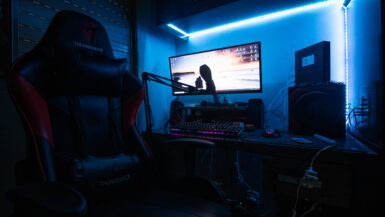In today’s increasingly interconnected world, the concept of a smart home is steadily becoming a reality for many. With voice-enabled smart home devices making daily tasks more convenient, it’s no wonder that homeowners are eager to integrate this technology into various aspects of their living spaces. One such area is the automation of blinds and shades, allowing for seamless control and enhancing energy efficiency. In this comprehensive guide, we will delve into the process of setting up voice control for your smart home’s blinds and shades, focusing on the compatibility of different systems, installation process, and the convenience that this technology can bring to your everyday life. Join us as we explore this innovative solution for making your home even smarter and more comfortable.
Top Voice-Controlled Smart Blinds and Shades: An Overview
As voice-enabled smart home devices become increasingly popular, homeowners are exploring new ways to make their living spaces more comfortable and efficient. One area that has seen significant innovation is window treatments, with voice-controlled blinds and shades offering a seamless solution for managing natural light, privacy, and energy consumption. In this section, we will discuss some of the top voice-controlled smart blinds and shades available on the market, focusing on their features, compatibility, and benefits.
Discovering the Best Voice-Controlled Smart Blinds and Shades
To help you make an informed decision, we have narrowed down the choices to the following top voice-controlled smart blinds and shades, each offering unique features and capabilities to suit different preferences and budgets:
1. Lutron Serena Smart Shades: Lutron’s Serena shades boast a sleek design and reliable performance. These shades are compatible with major voice assistants like Amazon Alexa, Google Assistant, and Apple HomeKit. With features like scheduling, geofencing, and integration with other smart home devices, Lutron Serena shades offer an impressive level of customization and automation.
2. SOMA Smart Shades 2: SOMA Smart Shades 2 is an affordable retrofit solution that transforms your existing blinds and shades into smart window treatments. With compatibility for Amazon Alexa, Google Assistant, and Apple HomeKit, SOMA Smart Shades 2 allows you to control your window treatments with just your voice.
3. Axis Gear: Axis Gear is another retrofit solution that upgrades your manual blinds or shades to smart ones. Compatible with Amazon Alexa and Google Assistant, this device offers a straightforward installation process and an intuitive app for easy control and scheduling.
4. IKEA Smart Blinds: IKEA’s smart blinds, known as Fyrtur and Kadrilj, offer an affordable entry point into the world of voice-controlled window treatments. Compatible with Amazon Alexa, Google Assistant, and Apple HomeKit, these blinds provide a user-friendly experience and can be easily integrated into your existing smart home ecosystem.
Compatibility with Voice Assistants: A Key Consideration
When selecting voice-controlled smart blinds and shades, compatibility with popular voice assistants is crucial. The majority of the top options mentioned above work seamlessly with Amazon Alexa, Google Assistant, and Apple HomeKit. This compatibility allows you to control your window treatments with simple voice commands, creating a truly hands-free experience. Before making a purchase, ensure that your chosen smart blinds or shades are compatible with your preferred voice assistant for maximum convenience and integration.
Benefits of Voice-Controlled Smart Blinds and Shades
The primary advantage of voice-controlled smart blinds and shades lies in the convenience they offer. With voice commands, you can easily raise or lower your window treatments without the need for manual adjustments or remote controls. Additionally, these devices can be integrated with other smart home systems, allowing for automation and coordination with your lighting, heating, and cooling systems to enhance energy efficiency and create a comfortable living environment.
In summary, voice-controlled smart blinds and shades provide a convenient and efficient solution for managing natural light, privacy, and energy consumption in your smart home. By selecting a compatible system and understanding its features and benefits, you can create a truly seamless and integrated home automation experience.
Step-by-Step Guide to Installing Voice-Controlled Window Treatments
Installing voice-controlled window treatments in your smart home can seem like a daunting task, but with the right guidance and preparation, it can be a smooth and rewarding process. In this step-by-step guide, we will provide you with a comprehensive approach to setting up voice control for your smart blinds and shades, ensuring a seamless integration with your preferred voice assistant and other smart home devices.
Step 1: Choose the Right Voice-Controlled Window Treatment Solution
The first step in installing voice-controlled window treatments is to select the most suitable solution for your needs. As discussed in the previous section, there are various options available, such as Lutron Serena Smart Shades, SOMA Smart Shades 2, Axis Gear, and IKEA Smart Blinds. Consider factors like compatibility with your preferred voice assistant, design aesthetic, and budget before making a decision.
Step 2: Assess Your Window Measurements and Installation Requirements
Before purchasing your voice-controlled blinds or shades, it is crucial to accurately measure your windows to ensure a proper fit. Measure the width and height of each window and make a note of any special installation requirements, such as the need for additional brackets or spacers. This information will help you choose the correct size and installation accessories for your smart window treatments.
Step 3: Gather the Necessary Tools and Materials
To ensure a smooth installation process, gather all the tools and materials you will need beforehand. This typically includes a power drill, screwdriver, level, tape measure, and any hardware included with your chosen smart blinds or shades. Additionally, ensure that you have a reliable Wi-Fi connection and your voice assistant device nearby for easy setup and integration.
Step 4: Install the Voice-Controlled Blinds or Shades
Follow the manufacturer’s instructions to install your chosen smart blinds or shades. This may involve attaching brackets to your window frame or wall, securing the blinds or shades to the brackets, and connecting any necessary wires or cables. Ensure that your window treatments are level and securely fastened for optimal performance and appearance.
Step 5: Connect Your Smart Window Treatments to Your Wi-Fi Network
Once your voice-controlled blinds or shades are installed, connect them to your Wi-Fi network using the manufacturer’s app or instructions. This will enable remote control and integration with your voice assistant and other smart home devices.
Step 6: Pair Your Smart Blinds or Shades with Your Preferred Voice Assistant
After connecting your smart window treatments to your Wi-Fi network, pair them with your preferred voice assistant, such as Amazon Alexa, Google Assistant, or Apple HomeKit. This process may involve linking your window treatment account to your voice assistant’s app and providing necessary permissions for seamless control.
Step 7: Configure and Customize Your Voice Commands
Once your smart blinds or shades are paired with your voice assistant, configure and customize your voice commands to suit your preferences. This may involve setting up custom names for each window treatment, creating scenes or routines for specific times of day, and configuring any additional settings available through your chosen blinds or shades.
With these steps completed, you can now enjoy the convenience and energy efficiency of voice-controlled window treatments in your smart home. By selecting the right solution, accurately measuring your windows, and following the installation and setup process carefully, you can transform your living space into a truly smart and integrated environment.
Integrating Smart Blinds with Popular Voice Assistants: Amazon Alexa, Google Assistant, and Apple HomeKit
As you set up voice control for your smart home’s blinds and shades, seamless integration with popular voice assistants is crucial for a smooth and user-friendly experience. In this section, we will explore how to connect your smart blinds and shades with Amazon Alexa, Google Assistant, and Apple HomeKit, ensuring that you can effortlessly control your window treatments using simple voice commands.
Connecting Smart Blinds and Shades with Amazon Alexa
Amazon Alexa is a widely-used voice assistant that offers compatibility with a wide range of smart blinds and shades. To integrate your smart window treatments with Alexa, follow these steps:
1. Install the Alexa app on your smartphone or tablet and sign in with your Amazon account.
2. Ensure that your smart blinds or shades are connected to your Wi-Fi network, as described in the manufacturer’s instructions.
3. In the Alexa app, tap the “Devices” tab, then select the “+” icon in the top-right corner to add a new device.
4. Choose “Blinds” or “Shades” from the list of device types, and select the specific brand of your smart window treatments.
5. Follow the on-screen instructions to link your blinds or shades account with the Alexa app, granting the necessary permissions for voice control.
6. Once connected, you can create custom names, scenes, and routines for your smart window treatments, enabling voice control using phrases like “Alexa, raise the living room shades.”
Integrating Smart Window Treatments with Google Assistant
Google Assistant is another popular voice assistant that offers compatibility with numerous smart blinds and shades. To connect your smart window treatments with Google Assistant, follow these steps:
1. Install the Google Home app on your smartphone or tablet and sign in with your Google account.
2. Make sure your smart blinds or shades are connected to your Wi-Fi network, as outlined in the manufacturer’s instructions.
3. In the Google Home app, tap the “+” icon in the top-left corner to add a new device.
4. Choose “Set up device,” then select “Works with Google” to view a list of compatible brands.
5. Find and select the specific brand of your smart blinds or shades, and follow the on-screen instructions to link your account and grant the necessary permissions.
6. Once connected, you can assign custom names, create rooms, and set up routines for your smart window treatments, enabling voice control using phrases like “Hey Google, lower the bedroom blinds.”
Pairing Smart Blinds and Shades with Apple HomeKit
Apple HomeKit is a powerful smart home platform that offers compatibility with various smart blinds and shades. To integrate your smart window treatments with Apple HomeKit, follow these steps:
1. Ensure that your smart blinds or shades are connected to your Wi-Fi network, following the manufacturer’s instructions.
2. Locate the HomeKit setup code provided with your smart window treatments. This code is typically found on the product packaging or within the manufacturer’s app.
3. Open the Home app on your iPhone or iPad, and tap the “+” icon in the top-right corner to add a new accessory.
4. Scan the HomeKit setup code or enter it manually, and follow the on-screen instructions to add your smart blinds or shades to your HomeKit home.
5. Once connected, you can create custom names, scenes, and automations for your smart window treatments, enabling voice control using phrases like “Hey Siri, open the kitchen shades.”
By successfully integrating your smart blinds and shades with popular voice assistants like Amazon Alexa, Google Assistant, and Apple HomeKit, you can enjoy the convenience and efficiency of voice control for your smart home’s window treatments. This seamless connection allows you to effortlessly manage natural light, privacy, and energy consumption, creating a truly smart and comfortable living environment.
Optimizing Voice Commands for Smooth Window Shade Automation
As you integrate voice control for your smart home’s blinds and shades, it is essential to optimize your voice commands for a seamless and efficient experience. In this subsection, we will explore various strategies and best practices for configuring your voice commands, ensuring smooth window shade automation and a truly hands-free experience.
Creating Custom Names for Your Smart Window Treatments
To optimize your voice commands, start by assigning custom names to each of your smart blinds or shades. This will make it easier to control individual window treatments with simple and specific voice commands. For example, naming your living room shades as “Living Room Shades” allows you to use commands like “Hey Google, lower the Living Room Shades.” Be sure to choose names that are easy to remember and pronounce to avoid any confusion.
Setting up Scenes and Routines for Different Times of Day
Another effective strategy for optimizing voice commands is to create scenes and routines for various times of day or specific occasions. By setting up these pre-configured automations, you can control multiple window treatments simultaneously with a single voice command. For example, you can create a “Good Morning” scene that raises all your shades and blinds, allowing for natural light to enter your home. Then, simply say “Alexa, activate Good Morning” to execute the scene.
Using Natural Language for Your Voice Commands
When configuring your voice commands, it’s important to use natural language that is easy to remember and understand. Avoid using technical jargon or complicated phrases, and instead, choose simple, conversational language for your commands. This will help ensure that your voice assistant accurately interprets your instructions and executes the desired actions.
Establishing Feedback Mechanisms for Confirmation
To enhance your voice control experience, consider setting up feedback mechanisms that provide confirmation of your commands. For example, you can configure your voice assistant to respond with a verbal confirmation, such as “Okay, raising the bedroom blinds,” when you issue a command. This feedback helps ensure that your instructions have been understood and executed correctly, offering peace of mind and greater confidence in using voice control for your smart window treatments.
By implementing these strategies and best practices, you can optimize your voice commands for smooth window shade automation in your smart home. Custom names, scenes, routines, natural language, and feedback mechanisms all contribute to a seamless and efficient experience, allowing you to effortlessly manage your smart blinds and shades using simple voice commands.
Enhancing Home Security and Energy Efficiency with Voice-Enabled Smart Blinds
Voice-enabled smart blinds and shades not only offer convenience and a seamless home automation experience, but they also contribute to enhanced home security and energy efficiency. In this subsection, we will explore various ways in which smart window treatments can improve the safety and sustainability of your smart home, providing both peace of mind and cost savings.
Utilizing Smart Blinds for Increased Privacy and Security
Smart blinds and shades can play a significant role in enhancing your home’s privacy and security. By integrating voice control, you can easily schedule your window treatments to open or close at specific times or based on your presence in the home. This can help deter potential intruders by creating the illusion of occupancy, even when you’re away. Additionally, voice commands allow you to quickly close your blinds for privacy or security purposes, providing an added layer of protection for your home and its occupants.
Automating Natural Light Control for Energy Savings
Voice-controlled smart blinds and shades enable you to automate the control of natural light in your home, resulting in substantial energy savings. By scheduling your window treatments to open during daytime hours or when sunlight is abundant, you can reduce your reliance on artificial lighting and decrease your energy consumption. Conversely, closing your blinds during hot summer days can help keep your home cool, reducing the need for air conditioning and lowering your overall energy costs.
Integrating Smart Blinds with Other Smart Home Devices for Optimal Efficiency
For optimal energy efficiency, consider integrating your voice-controlled smart blinds and shades with other smart home devices, such as thermostats, lighting systems, and security cameras. This interconnected approach enables coordination between various devices, allowing for automated adjustments based on factors like room occupancy, outdoor temperature, and sunlight levels. As a result, you can create a more comfortable and energy-efficient living environment that adapts to your specific needs and preferences.
Geofencing: A Smart Solution for Automatic Window Treatment Control
Another innovative feature offered by some voice-enabled smart blinds and shades is geofencing, which uses your smartphone’s GPS location to trigger specific actions when you enter or leave a designated area. By setting up geofencing, you can automatically have your blinds and shades open when you arrive home or close when you leave, ensuring privacy and security while also maximizing energy efficiency.
Incorporating voice-enabled smart blinds and shades into your smart home setup not only enhances convenience and comfort but also contributes to improved home security and energy efficiency. By utilizing features like scheduling, geofencing, and integration with other smart devices, you can create a safer and more sustainable living environment that caters to your unique needs and preferences.





Leave a reply